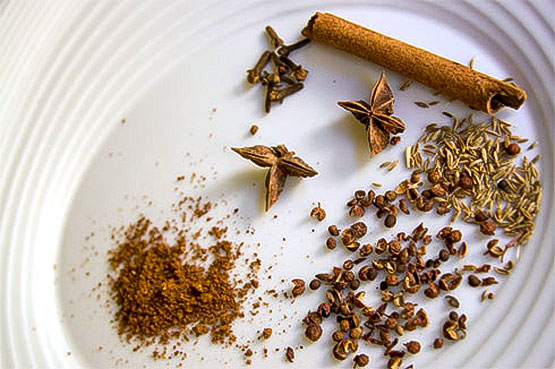5 Spice Braised Pork Belly – Perfect for rainy days
Braised Pork Belly is perfect for these windy, rainy days we’ve had recently around here. It’s perhaps a nod to my Asian heritage that my favorite way to braise is not with wine or rich stock, but simply with water and Five Spice powder. Western cooks turn their proverbial nose at braising with water, as my friend Daniel Patterson pointed out in his recent article in the New York Times, but Asian cooks have been braising with water for generations.
The key, besides the long braising time, is to make sure that the protein you use has enough fat and gelatin in the connective tissues to lend an unctuous quality to the resulting braising liquid. My protein of choice is pork belly, especially if I can find one with skin and rib bones still attached. When I use leaner protein such as chicken, I always throw the neck and feet into the braising liquid as well. They are entirely edible, but even if you don’t plan on gnawing at them, they provide the extra oomph you can taste in the sauce.
Browning the meat is less important, despite what Daniel told you in that article, and might even produce a less-than-perfect outcome. Pork skin, for example, can discolor and might even break when subjected directly to dry heat on the pan. There’s nothing much wrong with that, but I love the unbroken skin which, when bitten into, resists ever so slightly before letting you into that meltingly delicious fatty layer just underneath.
One thing I highly suggest you do is to make your own Five Spice powder. It’s so easy to do, and the result will be vastly superior to most commercial brands available in the West, which I find too overwhelming with anise. Should I want a purely anise-flavor braise I wouldn’t bother with Five Spice in the first place.
I also find that most spice blends use the cheaper and more easily available black peppercorns instead of the proper Sichuan peppercorns. And if you know
anything about anything at all you’d know that those two “peppercorns” share very little besides the misleading name. Sichuan “peppercorns” are not even peppercorns but dried outer pods of prickly ash fruits. They have an acidic note and give a tingling sensation on the palate – both entirely absent in the ubiquitous black peppers.
There are so many “recipes” for five-spice blends on the internet, most of which concentrate on five kinds of spice: star anise, Sichuan peppercorns, cassia (a type of Asian cinnamon, you can substitute regular cinnamon), and fennel. It seems that people take the “five” in “Five Spice” to mean a blend of five different spices. This is not entirely correct. The “five” in Five Spice actually refers to the balance of five basic elements: earth, fire, water, air, and metal.
The Five Spice powder was originally used in Chinese medicine to restore the balance of the five elements in the Chi or the life energy in our bodies. So, besides the five basic spices, Five Spice powder may contain other spices such as coriander seeds, cumin or anise seeds (instead of fennel seeds), black or green cardamom, and even nutmeg.
In my own Five Spice blend, I started out with an equal amount, by weight, of the five basic spices, though recently I’ve been using cumin seeds instead of fennel seeds. I found that the mix of star anise, cassia, and fennel seeds, all providing strong anise-y notes, became a little overpowering, so I opted for cumin seeds, which are very similar to fennel seeds but a little less anise-y and a bit more earthy. I also cut down the amount of clove by half and added coriander seeds and (sometimes) black cardamom to my blend, following the advice of a spice maker I knew in Bangkok’s Chinatown.
I recommend starting with whole spices if you can find them – ground spices lose their potency quickly, and you never know how old they’ve been loitering on the shelf. Starting with whole spices also allows you to dry roast them for a bit before grinding, which helps turn certain compounds in the spices more volatile, so your Five Spice blend ends up more fragrant and flavorful. You can easily double or quadruple the recipe to share with friends or keep for future use. Kept well in an airtight jar, your spice blend should last a few months in good shape.
I have a small coffee grinder I use for grinding spices. it’s just an inexpensive Kitchenaid Blade coffee grinder you can get on Amazon for not very much money. (Braun makes one even cheaper, if a bit smaller, though I prefer mine.) I grind my own chile blends and spice blends, so it’s a very good investment for me. It doesn’t take up much room in my crowded cabinet either. If you don’t have a spice grinder, just use a heavy mortar and pestle – it’s a bit more elbow grease but you can do it!
Five Spice Powder
Ingredients:
30g (1oz) star anise
30g (1oz) cassia (or cinnamon)
30g (1oz or 5 tbsp) Sichuan peppercorn
30g (1oz) cumin seeds
15g (0.5oz) clove
7g (0.25oz) coriander seeds
black cardamom (to taste, optional)

Directions:
On a dry pan over medium heat, roast each spice separately until just fragrant. They roast at different times so the easiest and safest thing to do is use a small pan and roast each one separately. Let the spices come back close to room temperature before grinding.
Depending on the size of your grinder, you might need to grind the spices in batches. In this case, it helps to grind each one separately as well. Blend all the ground spices together well in a large bowl before transferring them to spice jars.
Five Spice Braised Pork Belly
Once you’ve made the Five Spice powder from part I of this post, this dish is total child’s play. (Even if you didn’t make your own Five Spice powder you could easily substitute the store-bought stuff. Won’t be as good and it will do.) Once the braise is done, you could serve it on top of rice noodles, or any other kind of noodle that you like. You can even serve it on rice. I usually make a little chili-garlic-vinegar condiment to serve on the side. It adds a nice tang to cut through the fatty goodness in the belly.
Ingredients:
- 3-4 pounds skin-on pork belly, if you can find the belly with the rib bones attached, use it (rinse well and pat dry)
- 1 medium onion, diced
- 2-inch long knob of ginger, peeled and cut into thin slices, lengthwise
- 2 tbsp Five Spice powder
- 3 cloves of garlic
- 2tbsp cooking oil
- 2 tbsp dark soy sauce (You can substitute 2 tbsp regular soy sauce plus 1/2 tbsp brown sugar.)
- 3 tbsp fish sauce (plus more to taste)
- plus a handful of cilantro leaves for garnish.

Directions:
Take half the ginger slices and chop them finely. Reserve the rest for a bit later.
Use a large Dutch oven large enough in diameter to lay the pork belly flat in it. Heat the pan over medium-high heat, add the oil, then the diced onions. Cook until translucent, then add the chopped ginger and the Five Spice powder. Continue cooking the onions and spices, stirring vigorously, until fragrant, about two minutes.
Lay the pork belly flat, skin side down, on the pot over the onions and spices. Add enough water to completely cover the belly and then some. Add the dark soy sauce (or soy sauce + brown sugar substitute) and the fish sauce. Peel the garlic cloves, crush and then add them to the pot.
Put the lid on the pot, turn the heat up to high, and bring the pot to a boil. Skim any foamy scum from the top. Then, open the lid slightly, and let simmer over low heat for at least three hours (skim occasionally) or until the pork is falling off the bone tender.
Once the belly is ready, it should have by now shrunk a good deal, remove it from the large pot add it to a medium saucepan, and set it aside, covered. You should still have a good amount of braising liquid left in the big pot. It’s now time to reduce it to a thicker and more unctuous consistency. To do that, turn the heat back up to high, remove the lid, add the rest of the ginger slices, and let the liquid cook down until it’s the consistency you like. (This can take ten minutes, it might take a half-hour, you just have to keep watch and guesstimate yourself).
At this point, if you have a stick blender, I’d give it a whirl or two in the pot to blend everything together. If you don’t have one, don’t bother. In either case, strain the liquid into the medium saucepan with the cooked Braised Pork belly, and return the saucepan to the stove. Heat again until the pork belly is warmed through. You might want to check the seasoning again and add more fish sauce or soy sauce if it needs a bit more.
As I said earlier, you can serve this over rice or any kind of noodle you have. I usually blanch a bit of bok choy or other Asian vegetables and tuck them under the noodles. They provide a nice crunch and a fresh green flavor to the dish. It also helps to garnish with a bit of chopped cilantro.
If you like, you can also make my chili-garlic-vinegar condiment to drizzle over the pork to help cut through the fat a bit.
Ingredients:
1 clove of garlic, finely chopped
1-2 bird-eye peppers, finely chopped
4 tbsp rice vinegar
2 tbsp fish sauce
1/2 tbsp white sugar
Directions:
Mix well and serve as a condiment with the Braised Pork Belly.
A slight variation of this, using chicken thighs and legs, served with yellow egg noodles.
Reviews
Delightful Five-Spice Braised Pork Belly Recipe!
This five-spice braised pork belly recipe is an absolute gem! The flavors are a delightful fusion of sweet and savory, and the pork belly becomes incredibly tender and succulent. The recipe’s step-by-step instructions make it easy for even novice cooks to follow along. I was impressed by the depth of flavor achieved with simple ingredients, and the aromatic spices provided a delightful Asian-inspired twist. This dish is a definite winner, and I can’t wait to make it again for family and friends to enjoy!
